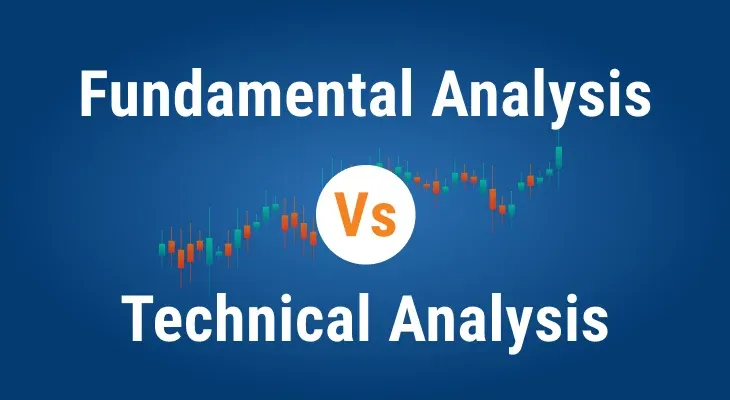
Difference between Fundamental & Technical Analysis
A thorough analysis of stocks before investing in them is crucial for achieving financial success. Without proper analysis, you may end up making decisions based on incomplete or inaccurate information, which can lead to losses and missed opportunities. There’s also the inadvertent risk of personal biases and emotions creeping into your decision-making.
Fundamental analysis and technical analysis are two different approaches that investors can use to analyse stocks before making investment decisions. Both methods are equally important and, together, can provide valuable insights for investors. Let us take a look at a brief overview of each approach, its importance, and the differences between them.
What is Fundamental Analysis?
This approach focuses on analysing a company's financial and economic fundamentals, such as earnings, revenue, assets, liabilities, management quality, and competitive position, among other factors. Fundamental analysis aims to determine the intrinsic value of a stock by assessing the company's financial health, growth prospects, and future earnings potential and can help you identify undervalued or overvalued stocks and make informed investment decisions.
Read Also: Fundamental Analysis of Stocks: Explained
What is Technical Analysis?
The key activities in technical analysis involve analysing the historical price and volume data of stock to identify patterns and trends. Investors and technical analysts use charts and other technical tools to assess the supply and demand for a company’s stock and predict future price movements. Technical analysis can help you identify potential entry and exit points for stock and manage risk by setting stop-loss orders.
Now that you know the definition of both, let us observe some of the main differences between fundamental analysis and technical analysis.
Read Also: Technical Analysis of Stocks
Key Differences Between Fundamental and Technical Analysis
Fundamental analysis and technical analysis are two different approaches to analysing stocks with these differences between the two:
Strategy And Focus
As covered in its definition, fundamental analysis largely focuses on analysing a company's financial and economic drivers. Technical analysis, on the other hand, focuses on analysing historical price and volume data to identify current and future patterns and trends.
Time Horizon
Fundamental analysis is typically used with a long-term investment horizon, as it aims to identify undervalued or overvalued stocks based on their intrinsic value. Technical analysis is often used with a short-term investment horizon, as it aims to identify trends and patterns that can be used to predict short-term price movements.
Data Sources
While fundamental analysis relies on publicly available financial and economic data, such as financial statements, economic indicators, and industry reports, the technical analysis relies on historical price and volume data, as well as charts and technical indicators.
Tools And Techniques
Fundamental analysis uses a variety of tools and methods, including financial ratios, discounted cash flow analysis, and comparative analysis. Technical analysis uses charts, trend lines, moving averages, and other technical indicators.
Subjectivity
Fundamental analysis is often considered more objective, as it is based on publicly available data and quantitative analysis. Technical analysis, on the other hand, is often considered more subjective, as it relies on interpreting charts and patterns, which can vary depending on the analyst.
Here’s a table highlighting the differences between fundamental and technical analysis for your quick reference.
COMPARISON FACTOR | FUNDAMENTAL ANALYSIS | TECHNICAL ANALYSIS |
|---|---|---|
| Definition and Objective | Analysis of securities to determine the intrinsic value of the stock and identify if it is overvalued or undervalued. | Uses charts and technical tools to identify historical patterns and trends to determine the future price of the stock and the right time to enter or exit the market. |
| Investment Horizon | Long term investments | Short term investments |
| Ideal For | Investing and trading for long-term positions | Investing and trading for long-term positions |
| Takes Into Account | Past and present data | Historical data only |
| Data Sources | Publicly available annual reports, news publications, and industry statistics | Past performance metrics plotted on charts and other statistical tools |
| Factors Considered | Macroeconomic factors, general economic indicators, industry benchmarks, and the company’s performance and growth prospects | Prices, time period, transactional volume, movement averages, and trend analysis |
Advantages of Using Fundamental Analysis and Technical Analysis
Here are some of the ways you can benefit from using fundamental and technical analysis:
Benefits Of Fundamental Analysis
Fundamental analysis focuses on the underlying financial and economic factors of a company and provides a long-term view of its potential growth and profitability.
The technique helps in identifying stocks that are undervalued relative to their intrinsic value, which can provide an opportunity for you to buy at a discounted price.
Fundamental analysis helps in understanding a company's financial health, including its revenue, profit margins, debt levels, and cash flows, which can provide valuable insights into its future prospects.
Benefits Of Technical Analysis
Technical analysis focuses on price and volume data and provides a short-term view of a security's potential price movements. By identifying the trends and patterns in a security's price movements, you can assess its future direction.
Using technical analysis, you can identify the optimal entry and exit points for a stock, helping you make short-term profits.
Furthermore, the approach provides useful risk management tools such as the stop-loss order, which can help you limit your losses in case the market moves against your expectations.
Read Also: Understanding the 3 Essential Phases of Trade Analysis
So, Which Approach Is Ideal For You?
As you would have realised by now, both fundamental and technical analysis come with their own set of merits and advantages. Fundamental analysis helps you identify stocks for long-term gains, while technical analysis helps you hedge your risks and identify the ideal time to buy or sell a stock. Fundamental analysis helps you identify companies with high-growth potential and technical analysis tells you when to invest in them.
A similar argument can be made that both fundamental and technical analysis have their limitations as well. For starters, fundamental analysis can be quite time-consuming as you need to sift through a large volume of information. Technical analysis suffers from the challenge of the limited information available in the public domain. Also, it relies heavily on historical data which may not always be a reliable predictor of future price movements. In addition, both techniques are subject to the possibility of misinterpretation.
Although some investors prefer one approach over the other, combining both approaches can provide a more comprehensive view of a stock's potential and help you make more informed investment decisions.
In Summation
Fundamental analysis can help investors understand the underlying financial health and growth potential of a company, while technical analysis can help investors time their entry and exit points based on market trends and patterns. By combining both approaches, investors can make informed investment decisions that balance risk and reward and help them achieve their long-term investment goals.
FAQ
Which approach is more suitable for beginners?
If you’re new to trading, then fundamental analysis might be more suitable for you as it provides a more comprehensive view of a company's financial health and future prospects. It is also easier to understand and interpret. Technical analysis, on the other hand, requires a more in-depth understanding of price and volume data and may be more suitable for experienced traders.
What is the main difference between fundamental and technical analysis?
The key difference between fundamental and technical analysis is the source of data used to analyse a company’s stock. While fundamental analysis focuses on a company's financial and economic factors, such as revenue, earnings, and industry trends, technical analysis focuses on price and volume data and identifies trends and patterns to predict future price movements.
Which approach is better for long-term investing, fundamental or technical analysis?
Generally, fundamental analysis is considered better for long-term investing as it provides a more comprehensive view of a company's financial health and future prospects. However, technical analysis can also be useful for identifying entry and exit points for long-term investments. It is ideal to use both approaches in combination with each other.
Which approach is better for day trading, fundamental or technical analysis?
Technical analysis is generally considered better for day trading as it focuses on short-term price movements and provides valuable insights into entry and exit points. Fundamental analysis is more focused on long-term growth potential rather than short-term price movements.


